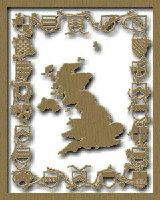
Explorations in Arthurian
History
A Literature Review
Part 3: Nennius and William of
Malmesbury
|

|
Short mention has been made of
Gildas,
a sixth-century monk who wrote about the Britain crumbling
around him. He is included in Arthurian research because he
mentions Badon
Hill. But he doesn't mention
Arthur. He talks about a character called "the Bear," which
can be drawn from the Celtic Art.
One monk who does is Nennius,
who lived in the ninth century in Bangor, in North Wales.
His Historia Brittonum is significant in that it
places Arthur in a time period that can be verified and it
gives us details of Arthur's military career. Nennius lists
12 battles won by Arthur, ending with the glorious victory
at Mons Badonicus. The locations of these 12 battles are
debated by various scholars and is a microcosm of the larger
debate over whether Arthur was a northern, western, or
southern king. For our purposes, Nennius's battle sites
stand for what they are.
|
|
Nennius, too, is given to exaggeration,
though he may be excused for merely passing on information:
He says that at the Battle of Badon Hill, Arthur
single-handedly killed 940 men. He also says Arthur went
into one of his 12 great battles with the sign of the Virgin
on his shield. This reference is probably an attempt to
Christianize Arthur, in the vein of the Grail. Indeed,
Nennius says of the 12 battles: "For no strength can avail
against the will of the Almighty." We have sketchy evidence
that Arthur was a person at all, and we have even shakier
ground on which to stand and say that Arthur was promoting
Christendom. More probably, Nennius had it in his mind to
modernize Arthur and draw him out of some of the paganism
associated with Welsh tales.
He makes two other mentions of Arthur,
both strange:
- In the first, he talks of a stone
having on it a pawprint of Arthur's dog, Cabal. Arthur is
said to have built a stone mound with the pawprint-stone
on top; this is called the Carn Cabal, and the stone is
said to reappear on top of the mound even though it had
been taken far away.
- The second reference to a tomb for a
man called Amr, who was said to be Arthur's son. Nennius
further says that Arthur "the solider" killed his son and
buried him. The mystery comes in here: "And men come to
measure the grave and find it sometimes six feet in
length, sometimes nine, sometimes twelve, sometimes
fifteen. At whatever length you might measure it at one
time, a second time you will not find it to have the same
length--and I myself have put this to the
test."
|

|